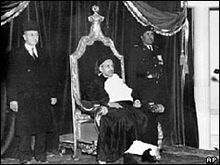- Omar Faiek Shennib
-
Omar Faiek Shennib 
Omar Faiek Shennib, to the left of King Idris al Senussi in 1951Born 1883
Derna, Ottoman EmpireDied 28 July,1953 (aged 69–70)
Tripoli, LibyaTitle Minister of Defence of Libya, Chief of Royal Diwans, Vice President of National Assembly Relatives Ahmed Fouad Shennib Omar al Fayek Shennib (Omar Faiek Shennib, Omar Shannib, Omar Shannaib)[1] was Libyan Minister of Defence, Chief of the Royal Diwan, Vice President of the Libyan National Assembly [2] under the reign of King Idris Al Senussi.
Contents
1941 Cyrenaican Delegation to the UN
Shennib served as President of the Cyrenaican delegation to the United Nations in the post-war period and was instrumental in the creation of a unified Libyan state in the years immediately following WWII following the withdrawal of Axis forces from the North African coast.[3] Together with Idris, Shennib comprised part of the 1941 delegation to the UN which put forth the case for the unification of the three traditional free standing regions, Cyrenaica, Tripolitania and Fezzan into the single nation state of Libya. Following independence on 24 December 1951, he was appointed Chief of the Royal Diwans [4]
Libyan Independence and Flag of Libya
Flag of Libya
Proportion 1:2 Adopted 3 August 2011 (1951) Design A horizontal tricolour of red, black and green with a white crescent and star centered on the black stripe Omar Faiek Shennib is credited for the design of the original Flag of Libya: this flag represented Libya from its independence until 1951 to 1969, and which was adopted by the pro-democracy movement during the 2011 civil war. According to the memoirs of Adrian Pelt, UN commissioner for Libya (1949 to 1951), “during deliberations of the Libyan National Constitutional Convention, a paper drawing of a proposed national flag was presented to the convention by Omar Faiek Shennib (distinguished member of the delegation from Cyrenaica). The design was composed of three colors; red, black and green, with a white Crescent and Star centered in the middle black stripe. Mr. Shennib informed the delegates that this design had met the approval of His Highness Emir of Cyrenaica, King Idris Al Senussi (later to become King of Libya). The assembly subsequently approved that design.”.[5]
Vice Presidency of the Libyan National Assembly
Shennib served as Vice President of the Libyan National Assembly until his death in 1953, and was a signatory to the first and only Libyan Constitution (as amended in 1961) [6]
Notes
- ^ Developments of the Quarter: Comment and Chronology Middle East Journal, Vol. 5, No. 3 (Summer, 1951), pp. 337-352
- ^ Developments of the Quarter: Comment and Chronology, Middle East JournalVol. 7, No. 4 (Autumn, 1953), pp. 504-519.
- ^ Fadhel Jamali, Mohommed. ‘Arab Struggle; Experiences of Mohammed Fadhel Jamali.’ Widener Library, Harvard University. WID-LC DS 7953.J34 1974x http://www.physics.harvard.edu/~wilson/Fadhel.html
- ^ Simons, Geoffrey Leslie. 'Libya: the struggle for Survival' pp 155
- ^ http://24dec1951.com/libya/national-flag-of-libya.html
- ^ Chronology of International Events and Documents, Royal Institute of International Affairs. Vol. 7, No. 8 (5–18 April 1951), pp. 213-244
Categories:- 1953 deaths
- Government ministers of Libya
- Libyan diplomats
- Libyan politicians
- 1883 births
Wikimedia Foundation. 2010.
